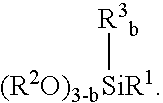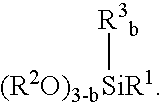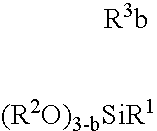Coated composite high voltage electrical insulator
a high-voltage electrical insulator and composite technology, which is applied in the direction of layered products, tire parts, transportation and packaging, etc., can solve the problems of polymer-based composite insulators that have failed and inconsistent performance, and the size and weight of glass or porcelain becomes excessive, and achieves high physical strength and adhesion. , the effect of easy and convenient application
- Summary
- Abstract
- Description
- Claims
- Application Information
AI Technical Summary
Benefits of technology
Problems solved by technology
Method used
Image
Examples
example 1
[0047]A first composition for coating electrical insulators was prepared by mixing 30 parts by weight of dimethyl polysiloxane fluid having a viscosity of 20,000 centipoise at 25° C. and 20 parts by weight of cyclic dimethyl siloxane then adding 2 parts by weight of surface treated amorphous silica (surface treated with hexamethyldisilazane) having a specific gravity of 2.2 and surface area of about 150 m2 / g. Then 2 parts by weight of methyl tris-(methyl ethyl ketoxime) silane and 1 part by weight of N-(2-aminoethyl-3 aminopropyl)trimethoxy silane are added and mixed under nitrogen atmosphere. Then 35 parts by weight of alumina trihydrate are added and mixed well to uniform consistency. The viscosity of the mixture was checked and adjusted to 1000±300 centipoise by adding extra amount of dimethoxy polysiloxane cyclics and amorphous silica respectively. Finally, 0.1 part by weight of dibutyltin dilaurate is added and mixed thoroughly.
example 2
[0048]A second electrical insulator coating composition was prepared by mixing 30 parts by weight of dimethyl polysiloxane fluid having a viscosity of 20,000 centipoise at 25° C. and 29 parts by weight of linear dimethyl polysiloxane of viscosity of 50 centipoise at 25° C., then adding 2 parts by weight of surface treated amorphous silica (surface treated with hexamethyldisilazane) having a specific gravity of 2.2 and surface area of about 150 m2 / g. Then 2 parts by weight of methyl tris-(methyl ethyl ketoxime)silane and 1 part by weight of N-(2-aminoethyl-3 aminopropyl)trimethoxy silane are added and mixed under nitrogen atmosphere. Then 35 parts by weight of alumina trihydrate are added and mixed well to uniform consistency. The viscosity of the mixture was checked and adjusted to 1000±300 centipoise by adding extra amount of dimethoxy polysiloxane linears and amorphous silica respectively. Finally, 0.1 part by weight of dibutyltin dilaurate is added and mixed thoroughly.
example 3
[0049]A solventless coating composition was prepared by mixing 46 parts by weight of polydimethylsiloxane fluid having viscosity of 2,000 centipoise and 4 parts by weight of surface treated amorphous silica (surface treated with hexamethyldisilazane) having specific gravity of 2.2 and surface area of about 130 m2 / g. Then 6 parts by weight of methyl tris-(methyl ethyl ketoxime)silane and 1 part by weight of N-(2-aminoethyl-3-aminopropyl)trimethoxy silane are added and mixed under nitrogen atmosphere. Then 40 parts by weight of alumina trihydrate were also added and mixed. To prepare a coating with desired colour 3 parts by weight of pigment paste were also added and mixed to a uniform consistency. The pigment paste was prepared by mixing 50 parts by weight of pigment powder into polydimethylsiloxane fluid. Finally 0.1 parts by weight of dibutyltin dilaurate is added and mixed thoroughly.
[0050]The finished product has a viscosity that makes it suitable for application by roller and br...
PUM
| Property | Measurement | Unit |
|---|---|---|
| viscosity | aaaaa | aaaaa |
| viscosity | aaaaa | aaaaa |
| particle size | aaaaa | aaaaa |
Abstract
Description
Claims
Application Information
 Login to View More
Login to View More - R&D
- Intellectual Property
- Life Sciences
- Materials
- Tech Scout
- Unparalleled Data Quality
- Higher Quality Content
- 60% Fewer Hallucinations
Browse by: Latest US Patents, China's latest patents, Technical Efficacy Thesaurus, Application Domain, Technology Topic, Popular Technical Reports.
© 2025 PatSnap. All rights reserved.Legal|Privacy policy|Modern Slavery Act Transparency Statement|Sitemap|About US| Contact US: help@patsnap.com



